Did you know that the 1972 Jefferson Nickel sitting on your palm is potentially worth $2,700? But before you take high-quality pics and post your listing on eBay, there are certain things you need to know about the value of 1972 Nickels and the factors that affect their value. Luckily, that’s exactly what we are here to discuss.
But before we get into the nitty-gritty, below is a summary of the value of the 1972 Nickel.
1972 Nickel Value at a Glance
The two biggest factors that affect the value of the 1972 Nickel are coin condition and variety. Condition in this context refers to the extent to which a coin is circulated. Circulated 1972 Nickels are worth between 10 and 20 cents. Uncirculated 1972 Nickels, on the other hand, are worth between $0.25 and $2,700.
Coin Valuation Chart
| Coin Condition | Estimated Value | ||
| 1972-P Nickel | 1972-D Nickel | 1972-S Proof Nickel | |
| Heavily Circulated
(G4 – XF40) |
$0.10 | $0.10 | – |
| About Uncirculated (AU50 – AU58+) | $0.10 – $0.20 | $0.10 – $0.20 | – |
| Uncirculated
(MS60 – MS64+) |
$0.25 – $20.00 | $0.25 – $25.00 | $0.30 – $4.00 |
| Brilliant Uncirculated (MS65 or higher) | $15 – $2,700 | $15 – $400 | $1.75 – $115 |
1972 Nickel: Historical Background
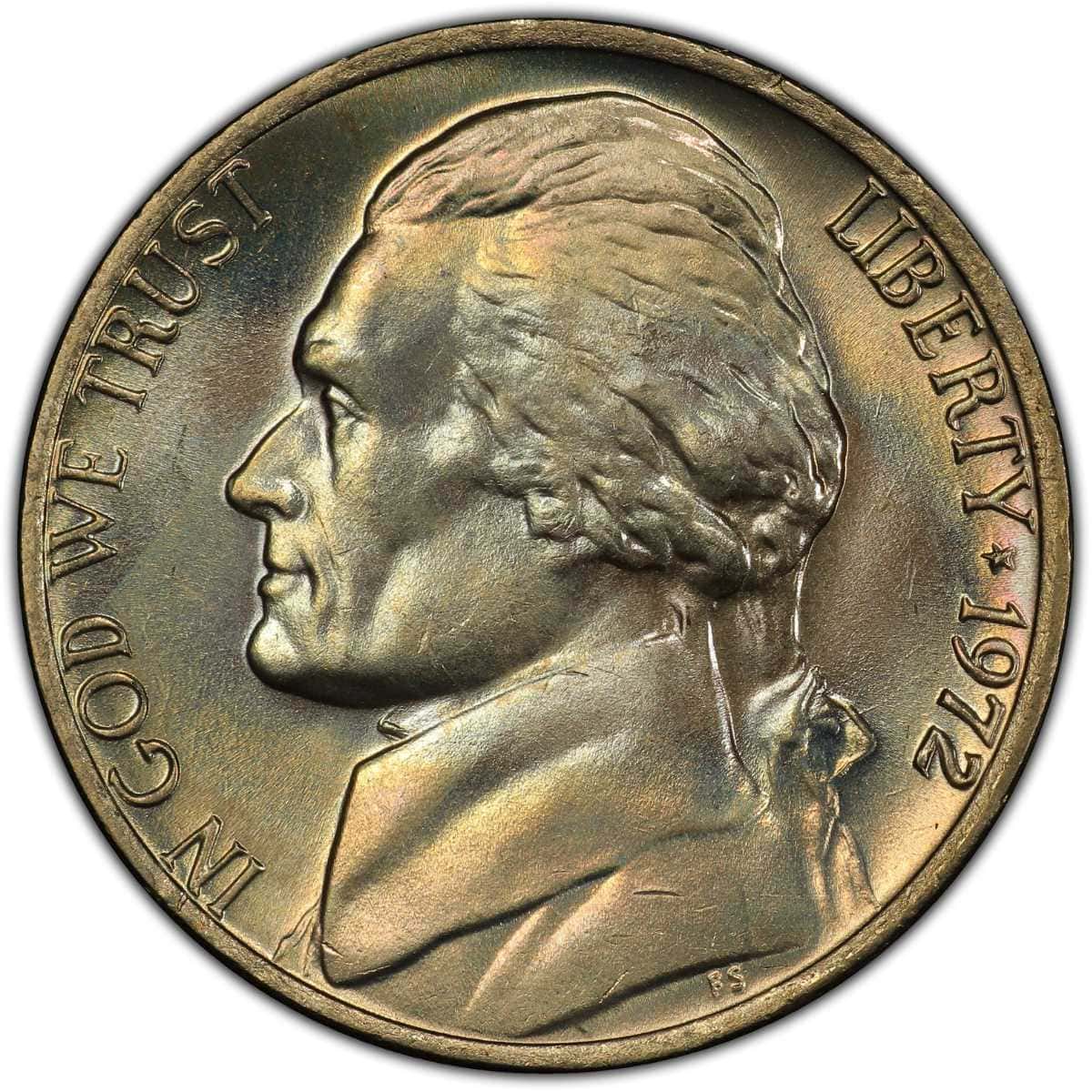
Unfortunately, 1972 is not a key date in the Jefferson Nickel. But that does not mean that the 1972 Nickel lacks some valuable varieties. Suppose you flip any Jefferson Nickel and observe its reverse. In that case, you’ll notice that the coin depicts Monticello, the residence of the third president of the U.S., Thomas Jefferson.
Historically, the U.S. Mint has struggled to engrave the steps of Monticello on the Jefferson Nickel. Most 1972 Nickels from the Denver and Philadelphia Mints left the production line with fuzzy steps.
Only a few nickels were well-struck with full and distinctive steps. The distinction between the two strikes led to the rise of the Full Steps variety of the Jefferson Nickels. And because examples with fuzzy steps were the majority, we, in the hobby, refer to them as Regular strikes.
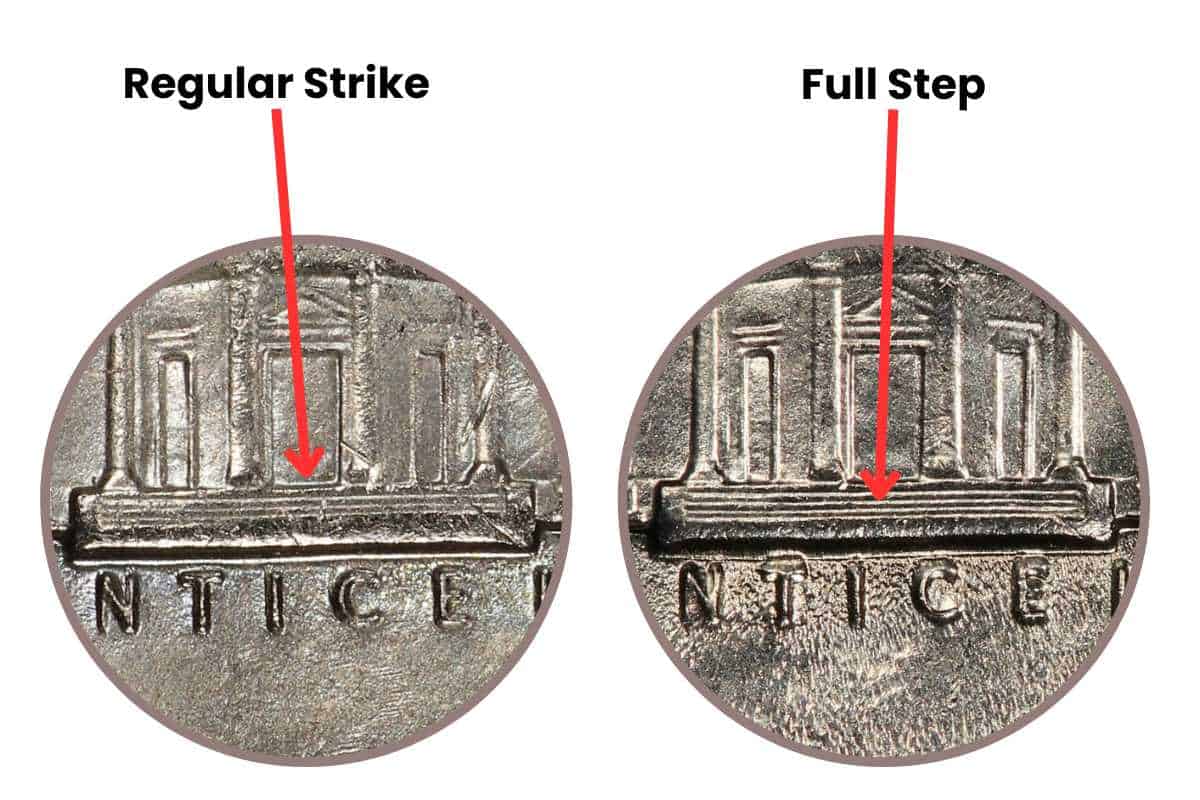
Even among the Full Steps nickels, there are two sub-varieties. Some coins will show five steps on Monticello, and others will show six steps on the historic mansion.
Caring for the Full Steps 1972 Nickels is difficult as the detail on those steps is very susceptible to wear. Because of these circumstances, 1972 Nickels with full steps will be in mint condition. The Full Steps are more sought after than the Regular Strikes due to their rarity, superior eye appeal, and mint condition.
So, is your 1972 Jefferson Nickel showing full steps? Keep reading to find out its worth.
1972 Nickel: Coin Anatomy and Feature
While the 1972 Nickel is silver-colored, it does not contain any silver. The silver appearance you see is the color of nickel, which contributes 25% of the coin’s metallic composition. The other 75% is made of copper, which sometimes appears on worn 1972 Nickels.
Some 1972 Nickels will be showing a hint of redness over the silver color. This redness is exposed copper. To understand more about the colors of the nickel, check out our coin color guide.
The combination of these metals gives the 1972 Nickel a mass of five grams or 0.18 ounces. If your penny is weighing differently, it was probably struck on the wrong planchet. Another feature worth measuring is the coin’s diameter. The standard diameter of the 1972 Nickel is 21.21 millimeters or 0.84 inches.
Obverse Design and Features

Between its inception in 1938 and 2003, the Jefferson Nickel has used the same designs for its obverse and reverse faces. The 1972 Nickel bears the same designs that Felix Schlag sculpted in 1938. Since then, the mint mark has been shuffled around, and Schlag’s initials were added in 1966.
By the time 1972 rolled around, the obverse of the nickel included the following characters on its obverse:
- The left-facing profile of Thomas Jefferson
- The legends “LIBERTY” and “IN GOD WE TRUST.”
- A solitary star
- The date “1972”
- The mint mark, “D,” “S,” or neither
- Felix Schlag’s initials “FS”
Reverse Design and Features

As for the reverse of the 1972 Jefferson Nickel, it contains the following elements:
- President Jefferson’s mansion, Monticello
- The inscription “MONTICELLO.”
- The legend’s “E PLURIBUS UNUM” and“UNITED STATES OF AMERICA”
- The denomination “FIVE CENTS”
1972 Nickel: Mint Marks and Varieties
As is common with many U.S. coins, the production of the 1972 Jefferson Nickel was a joint effort involving the Philadelphia, Denver, and San Francisco Mints. Each facility stamped its mint mark on the coins they struck, giving us three main varieties.
1972-P Nickel Value

- U.S. Mint: Philadelphia
- Mintage: 202,036,000
- Mint Mark: None
The value of the 1972-P Nickel is influenced by many factors, including population, variety, and demand. There’s not a lot of interest in these coins. There are many other coins collectors would rather have.
As for population, the 1972-P Nickel is plentiful until the MS66 grade. MS67 examples will be fewer, and MS68 gems will be almost unheard of.
The most common variety is the Regular-Struck 1972-P Nickel. These coins exist in both circulated and uncirculated states. In circulated conditions, their values typically range between 10 and 20 cents, depending on their condition. In mint condition, these coins are worth between $0.25 and $40.
Examples showing Five Steps are mostly available between the MS64 and MS66 states. At these states, 1972-P Nickels with Five Steps are worth between $15 and $250. MS67 examples of this variety are extremely rare, and they sell for a premium. They are worth an eye-watering $2,700.
Examples with Six Steps on Monticello may be attainable in MS65 condition, but they are pretty rare in MS66 state. In these states, the nickels are worth $125 and $600, respectively.
| Coin Condition | Estimated Value | ||
| Regular Strike | Five Steps | Six Steps | |
| Good (G4) | $0.10 | – | – |
| Very Good (VG8) | $0.10 | – | – |
| Fine (F12) | $0.10 | – | – |
| Very Fine (VF20) | $0.10 | – | – |
| Extremely Fine (XF40) | $0.10 | – | – |
| About Uncirculated (AU50) | $0.10 | – | – |
| About Uncirculated (AU58) | $0.15 | – | – |
| Uncirculated (MS60) | $0.25 | – | – |
| Uncirculated (MS64) | $5 | $15 | – |
| Brilliant Uncirculated (MS65) | $15 | $30 | $125 |
| Brilliant Uncirculated (MS66) | $40 | $175 | $600 |
| Brilliant Uncirculated (MS67) | $150 | $2,700 | – |
Some coins struggle to realize their estimated values on the open market while others blow past them—a 1972-P Nickel with the rare MS67 grade sold for $410 in 2021. While the coin failed to show full steps on Monticello, it still blew past our $150 valuation.
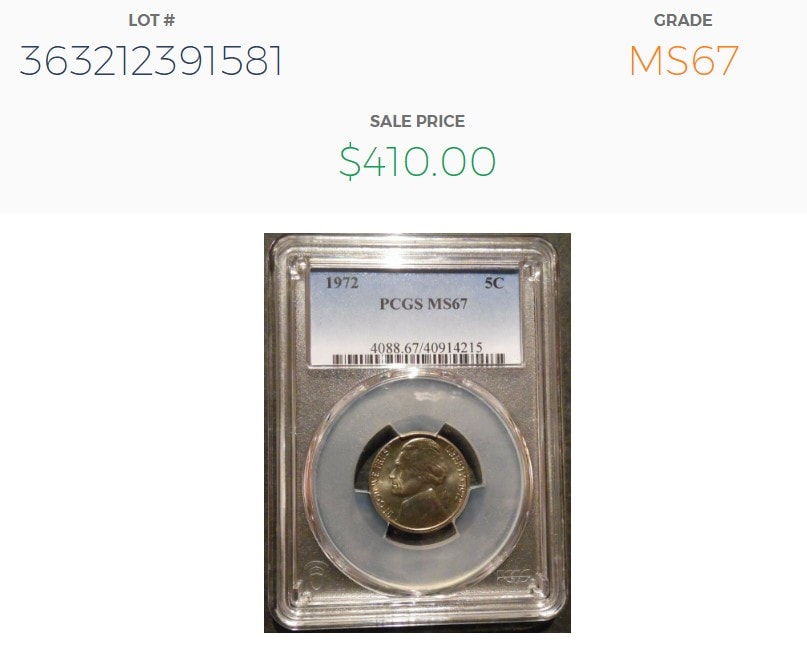
One 1972-P Nickel that struggled to meet its valuation had a grade of MS67FS and only sold for $2,500 despite showing five steps. Another example is an MS66FS grade sold on Stack’s Bowers for $1,080.
1972-D Nickel Value
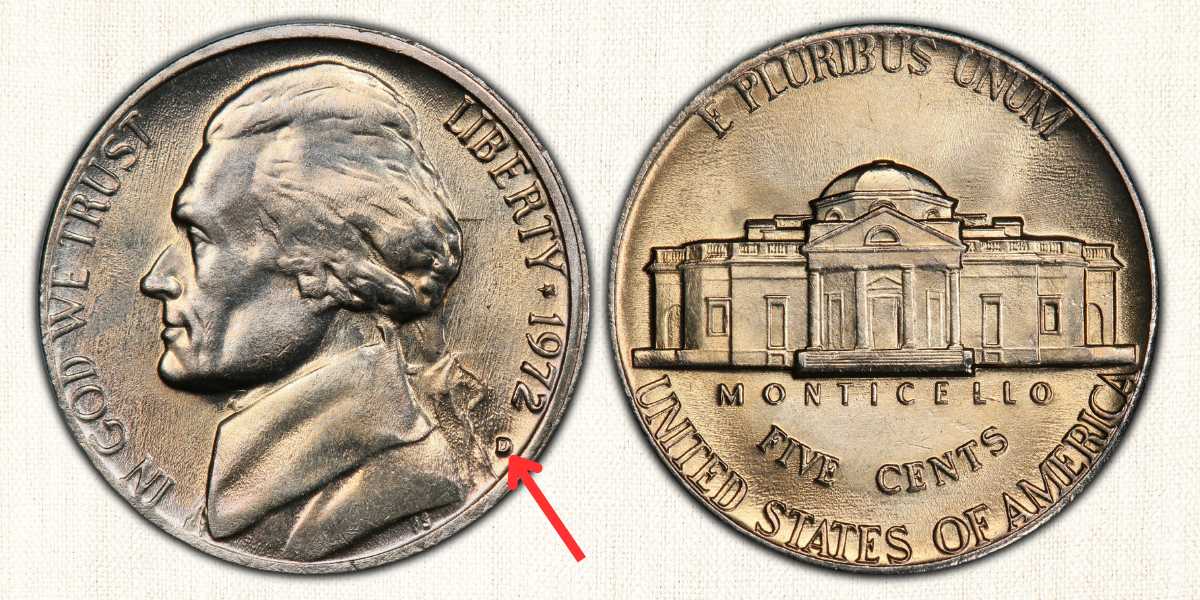
- U.S. Mint: Denver
- Mintage: 351,694,600
- Mint Mark: D
The 1972-D Nickel is also plentiful until the MS66 condition. In this variety, examples of the MS67 grade are quite rare.
In circulated conditions, 1972-D Nickels will be showing fuzzy steps. In this condition, the value of these coins ranges from 10 to 20 cents.
In uncirculated condition, these coins are pretty attainable until the MS67 state. We value such coins between $0.25 and $60. The rare MS67 gems are worth about $400.
Examples showing Five Steps are typically available in MS64FS and MS65FS states. Such coins are valued at $20 and $30 respectively. Gems graded MS66FS and MS66+FS are quite elusive. We v alue them at $120 and $215, respectively.
1972-D Nickels showing Six Steps are very rare. A few examples have popped up in the MS66 condition and are worth $400.
| Coin Condition | Estimated Value | ||
| Regular Strike | Five Steps | Six Steps | |
| Good (G4) | $0.10 | – | – |
| Very Good (VG8) | $0.10 | – | – |
| Fine (F12) | $0.10 | – | – |
| Very Fine (VF20) | $0.10 | – | – |
| Extremely Fine (XF40) | $0.10 | – | – |
| About Uncirculated (AU50) | $0.10 | – | – |
| About Uncirculated (AU58) | $0.15 | – | – |
| Uncirculated (MS60) | $0.25 | – | – |
| Uncirculated (MS64) | $5 | $20 | – |
| Brilliant Uncirculated (MS65) | $15 | $30 | – |
| Brilliant Uncirculated (MS66) | $35 | $120 | $400 |
| Brilliant Uncirculated (MS67) | $400 | – | – |
We could only find two sales involving 1972-D Nickels of MS67 quality. Both of them were regular strikes, with one selling for $322 and the other only managing to realize a price of $139.00.
1972-S Proof Nickel Value
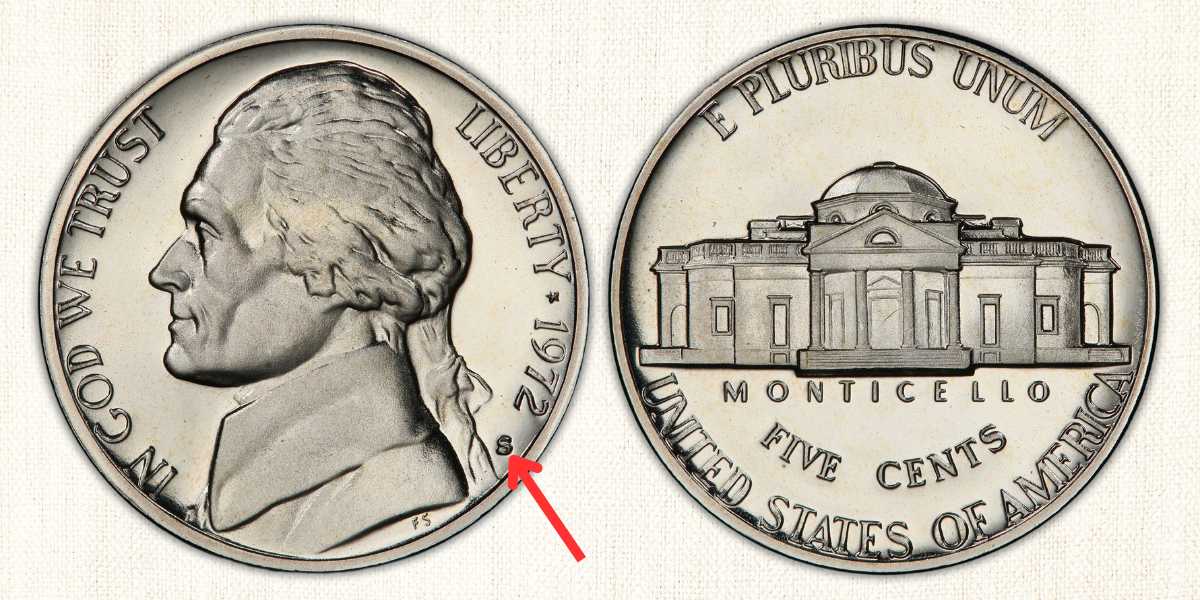
- U.S. Mint: San Francisco
- Mintage: 3,260,996
- Mint Mark: S
The 1972-S Proof Nickel was struck in a period when coin collecting was gaining popularity as a viable hobby. Coin collectors from this era bought these coins and kept them pristine. While this practice was a win for the hobby, it negatively affected the value of proof coins.
Uncirculated proof coins are worth between $0.30 and $12.50.
The slightly superior Cameo (a finish with a frosted design and mirror-like fields) bunch is plentiful between the PR64 and PR69 states. In these conditions, their value ranges between $4 and $20.
In Deep Cameo, the 1972-S Proof Nickels are available between PR65 and PR69. Coins of these qualities can hold a value of as little as $10 and as much as $115.
| Coin Condition | Estimated Value | ||
| Proof (PR) | Cameo (CAM) | Deep Cameo (DCAM) | |
| Uncirculated (PR60) | $0.30 | – | – |
| Uncirculated (PR61) | $0.40 | – | – |
| Uncirculated (PR62) | $0.65 | – | – |
| Uncirculated (PR63) | $0.90 | – | – |
| Uncirculated (PR64) | $1.25 | $4 | – |
| Uncirculated (PR65) | $1.75 | $7 | $10 |
| Uncirculated (PR66) | $2.50 | $10 | $13 |
| Uncirculated (PR67) | $5 | $13 | $17 |
| Uncirculated (PR68) | $7.50 | $15 | $20 |
| Uncirculated (PR69) | $12.50 | $20 | $115 |
| Uncirculated (PR70) | – | – | – |
Regardless of the above-quoted figures, the 1972-S Proof Nickel has sold some valuable gems. In 2003, a 1972-S Proof Nickel was auctioned on Heritage Auctions for $460. The coin was graded PR69 and was showing a Deep Cameo. A similar-graded coin was sold in the same year for $207.
1972 Nickel: Common Error Coins
Sometimes, when the value of a coin is low, it pays to redirect your attention to error coins. Below are the common error coins in the 1972 Nickel’s roster:
1972 Nickel Die Clash Error

When dies strike without a blank planchet between them, they clash with intense force. This clash causes the dies to imprint themselves on their opposites. When a blank is struck after the clash, you get a coin with faint outlines of their opposite face.
For example, this 1972-S Nickel shows a faint outline of the “O” of “MONTICELLO” behind Thomas Jefferson’s head. It also shows an outline of Jefferson’s head on the reverse. With a grade of PR67, this gem is up for sale on eBay for $399.
1972 Nickel Die Crack Error

Apart from clashing, dies can crack, too. And when they do, they imprint the crack on the coins they struck. In the image above, a 1972-S Proof Nickel with a similar error on its obverse. The error was confirmed by NGC, who gave the coin a grade of PR66DCAM. The seller of this gem is willing to let it go for $139.
Nickel Struck on Wrong Planchet Error

Because all the mints strike multiple denominations, planchet mix-ups are quite common. We found a 1972-D Nickel that was struck on a penny planchet. Because penny planchets are two millimeters smaller, centering was an issue. This bronze-colored nickel was struck with an off-center error. Despite the coin’s shortcomings, it sold in 2001 for $750.
1972 Nickel Uniface Error

While die clashes result from the lack of planchets in the coin chamber, uniface errors arise from striking two blanks simultaneously. After striking, the faces in contact with the dies will be engraved, while those facing away will remain blank.
In the aftermath of the strike, you end up with two coins, each showing a blank face—one 1972-S Proof Nickel with a uniface obverse error sold for $1,116.25 in 2015. While there’s nothing wrong with its obverse face, its reverse is completely blank. Its sister coin (with a Uniface Reverse) sold on the same day for $998.75.
1972 Nickel Double Struck Error

Sometimes, a coin fails to eject after striking. Unless it’s manually removed from the coin chamber, the planchet will be struck again. Because the coin is struck twice, we call the anomaly a Double Struck Error.
When it comes to double-struck 1972 Nickels, no specimen is finer than this 1972-S Proof Nickel. First of all, the coin is in the pristine state of PR67. It appears as though it was struck off center on the first round, ejected partially, and then struck again. After a highly-contested bidding war in 2008, the nickel sold for $4,312.50.
Final Thoughts
To call a spade a spade, the 1972 Jefferson Nickel is not such a valuable coin. Even proof coins can be had in PR69 condition for less than $13. However, there are a couple of varieties that you want to keep an eye on: the 1972-D and 1972-P Nickels with full steps. In the right condition, these coins can sell for thousands of dollars, which is not bad for a coin that was once worth five cents.
Certain error coins can also be profitable. As we’ve seen, Uniface errors, Die Clashes, and Double Struck errors can sell for hundreds or even thousands of dollars. You can buy rolls or even boxes of Jefferson Nickels and try to fish out some of these error coins. You never know the treasures that await.

Jenson is a professional numismatist, a dedicated coin collector, a graduate of the College of Business at Oregon State, a life member of the American Numismatic Association (ANA), and an overall coin nerd. He is the founder of Coin Value List.
